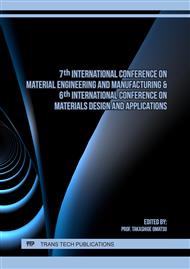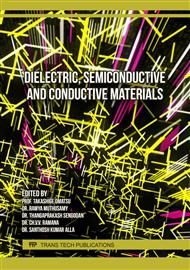p.3
p.13
p.21
p.27
p.37
p.45
p.51
p.61
p.69
Morphology and Mechanical Properties of High Density Polyethylene and Ethylene-Methyl Acrylate Copolymer Blends with Organoclay
Abstract:
In this research, the effect of ethylene-methyl acrylate copolymer (EMAC or EMAC30) and clay surface modified with aminopropyltriethoxysilane 0.5-5 wt% and octadecylamine 15-35 wt% (Clay-ASO) on the morphological, mechanical, and thermal properties of high density polyethylene (HDPE) were investigated. The polymer blends and composites were prepared by an internal mixer and then samples were molded by compression molding. The morphology analysis showed that the presence of fibrous surface at the specimen fracture surface of HDPE/EMAC30 blends. The phase morphology of HDPE blends with Clay-ASO 3, 5 and 7 phr was observed the phase separation of EMAC30 and aggregate of Clay-ASO at high EMAC30 content. Young’s modulus of HDPE/Clay-ASO composites increased with increasing Clay-ASO composites. The presence of Clay-ASO did not improve Young’s modulus and tensile strength of HDPE/EMAC30/Clay-ASO composites. The strain at break of HDPE/EMAC30 blends increased with increasing EMAC30 content. The incorporation of EMAC30 and Clay-ASO had no effect on the melting temperature of HDPE blends and composites, respectively. The percent crystallinity of HDPE/EMAC30 and HDPE/EMAC30/Clay-ASO was lower than that of pure HDPE. The addition of EMAC30 and Clay-ASO decreased the degradation temperatures of HDPE/EMAC30 blends and composites.
Info:
Periodical:
Pages:
37-42
Citation:
Online since:
October 2023
Price:
Сopyright:
© 2023 Trans Tech Publications Ltd. All Rights Reserved
Share:
Citation:



